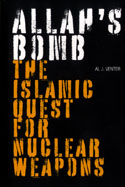 Allah’s Bomb: The Islamic Quest for Nuclear Weapons
Allah’s Bomb: The Islamic Quest for Nuclear Weapons
Reviewed by Steve Dunham
This Day Forward dramatizes the true story of Mike Jensen and his family as they cope with life after his diagnosis with a brain tumor at
 Allah’s Bomb: The Islamic Quest for Nuclear Weapons
Allah’s Bomb: The Islamic Quest for Nuclear WeaponsBy Al J. Venter
Guilford, CT: Globe Pequot Press, 2007
274 pp., $24.95 hardcover
Reviewed by Steve Dunham
Journal of Homeland Security, 2008. Copyright 2008 Analytic Services. Reproduced by permission.
Veteran war correspondent Al Venter looks at the ample evidence that Islamic countries and
Venter reckons the likelihood of nuclear weapons use as high. Iran, he says, is serious about destroying Israel and about acquiring nuclear weapons. He sees no real need for nuclear power generation in oil-rich Iran, and he says that in covering its true intentions, Iran has been “lying fluently from Day One.”
Furthermore, his work as a war correspondent in the Mideast left him with one “lasting
There was joy throughout the Islamic world on
But “Israel is a democracy and does not threaten anyone,” Venter quotes Israeli prime minister Ehud Olmert as saying in 2006, and Venter quotes an earlier prime minister, Yitzhak Rabin, as saying, “Israel will not be the first country in the region to use nuclear weapons. Nor will it be the second.” Indeed, according to Venter, some Islamic countries are seeking nuclear weapons not for an attack on Israel but for deterrence against their Islamic neighbors.
But if Israel resorts to using nuclear weapons, even if it is not the first or second to do so, the results would be fearful. “Should Iran, or one of its surrogates, like Hezbollah (or even
Yet even with Iran’s apparent intent to acquire and use atomic weapons, the danger of terrorists’ acquiring them is even more serious than the threat from Iran, according to Mohamed ElBaradei, head of the International Atomic Energy Agency, quoted by Venter. Much nuclear smuggling is undetected, says Venter, and there are numerous sources of radioactive material—if not plutonium or highly enriched uranium for an atomic weapon, then other dangerously radioactive material for use in a radiological dispersal device or “dirty bomb.” South African physicist Nic
However, groups that lack the technology might be able to steal or buy weapons or parts. Iraq purchased nuclear technology from Europe, although export controls prevented it from acquiring some materials that were crucial to weapons production, says Venter.
Pakistan, moreover, and its notorious
So what can the world do to prevent or slow the proliferation of atomic weapons into the hands of more people who are inclined to use them? The International Atomic Energy Agency “has lost the trust of the majority of the countries that matter,” writes Venter. “Years of procrastination, prevarication, hand-wringing, and sometimes infuriating inactivity” have been coupled with “the inability of the United Nations to vote on issues of critical international interest.”
The U.S.-led Proliferation Security Initiative “has had some success,” says Venter, noting that it has interdicted more than
Venter doesn’t predict that such measures will prevent disaster, however. Rather, he seems convinced that people who hate each other will get atomic weapons if they don’t have them already and then use them on each other.
Overall, his experience and inside knowledge seem convincing, though the book would have benefited from more careful editing. There are occasional typographical mistakes, such as Israel’s
Venter’s conversational style, relying sometimes on unnamed sources, gives the impression of a sit-down chat with someone who has just returned from a war—a war that isn’t over.
 Angry Wind: Through Muslim Black Africa by Truck, Bus, Boat, and Camel
Angry Wind: Through Muslim Black Africa by Truck, Bus, Boat, and CamelBy Jeffrey Tayler
New York: Houghton Mifflin, 2005
249 pp., $25 hardcover
Reviewed by Steve Dunham
Journal of Homeland Security, 2006. Copyright 2006 Analytic Services. Reproduced by permission.
In 2003, Tayler traveled through the Sahel: the lands on the southern edge of the Sahara Desert. He spent time in Chad, Nigeria, Niger, Mali, and Senegal, mostly in regions of desperate poverty. Fluent in Arabic and French, and having lived in Morocco, he was adept at communicating with and understanding Africans.
This is a travel book, with vivid descriptions of the countries, cities, climate, and culture. The people—individuals and masses—come to life. The landscape and scenery are serenely beautiful and achingly harsh.
It is also partly a political book. It contains numerous conversations with Muslims, who constitute the majority of the population in the Sahel, and in a few places Tayler offers his own bleak interpretation of the future in these places. For anyone interested in international affairs or homeland security, it is worthwhile to sit and listen to Tayler and the Africans with whom he spoke.
“Al-Qa’ida has been active in Africa, perpetrating acts of terrorism in Kenya, Tanzania, and
The people of the Sahel are mostly fundamentalist Muslims with tribal rather than national identity, and many of them are disillusioned or angry with the United States, particularly with President Bush. “His election was not democratic,” a government functionary in Chad said to Tayler. “Look, think of what this means to people in Chad who believed in
Tayler encountered prevalent anger against Bush (though not necessarily against individual Americans) for the war in Afghanistan and the then-imminent invasion of Iraq. This anger, he predicted, would be fueled by the hopelessness of the region’s economy despite Western aid.
“As populations grow, the desert expands, food and water become even scarcer, and the confrontation between the West and the Islamic world intensifies, whatever peace existing now in the Sahel will probably turn out to be a lull before a regional apocalypse,” wrote Tayler, who predicted “misery and rage and death for the Sahelians, a barricaded Europe, and vast territories available for anti-Western terrorism.” The wretched Sahelians, he wrote, are “orphaned of Western defenders, ever leaner, ever hungrier, increasingly angry, serving their sentences, awaiting an
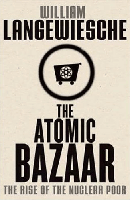 The Atomic Bazaar: The Rise of the Nuclear Poor
The Atomic Bazaar: The Rise of the Nuclear PoorBy William Langewiesche
New York: Farrar, Straus and Giroux, 2007
179 pp., $22 hardcover
Reviewed by Steve Dunham
Journal of Homeland Security, 2007. Copyright 2007 Analytic Services. Reproduced by permission.
In The Atomic Bazaar: The Rise of the Nuclear Poor, William Langewiesche describes how we are entering a “world in which many countries have acquired atomic bombs, and some may use them.”
He quotes an experienced Russian “Cold War hand” who later got involved in selling nuclear power-generation technology to undeveloped countries: “No one thought that proliferation could come from Arab countries.” The Nuclear Non-Proliferation Treaty “was aimed at dissuading the developed countries from acquiring nuclear weapons—and it worked because they accepted the U.S. and Soviet nuclear umbrellas.” Smaller countries realized that they didn’t need retaliatory nuclear weapons of their own as deterrents against attack. But “the great powers were stuck with arsenals they could not use, and nuclear weapons became the weapons of the poor” countries, which acquired nuclear power technology thanks to lax export laws in many countries and to companies that had an eye on profit more than on national security.
“The poor,” says Langewiesche, “for a host of reasons, are more likely to use their nuclear weapons than the great powers have
Langewiesche, however, gives solid reasons why acquiring a nuclear weapon or the means to manufacture one would be very difficult (though not impossible). He describes the technology involved, which he says is not truly secret, just hard to work with and hard to conceal. He describes the security surrounding nuclear weapons and fissionable materials; even in Russia, where physical security is often poor, there are formidable obstacles to penetrating a nuclear city such as Ozersk, stealing bomb materials, and then escaping with them. In the film Last Best Chance, he says, terrorists do exactly that, but the film ends with their escape from the facility, carrying stolen nuclear materials, whereas in reality they would still be hundreds of miles from an open border, with scant chance of reaching it if the theft were discovered. It would not be impossible, just daunting.
The technical obstacles to building, rather than stealing, an atomic bomb are exemplified by the story of Abdul Qadeer Kahn, to which Langewiesche devotes much of the book. Kahn was personally responsible for Pakistan’s acquisition of a nuclear arsenal and for proliferation of nuclear weapons to other states, such as North Korea. Kahn did not steal secrets so much as shortcuts, says the author. Even with shortcuts, it took Pakistan about
The greatest threat to the United States caused by the proliferation of nuclear weapons would be an atomic bomb in the hands of jihadists, who, Langewiesche points out, would not hesitate to use it. Poor countries with atomic arms might be more likely to use them against each other. If Pakistan were to use one of its atomic bombs, the target would almost certainly be India, not the USA.
“It seems entirely possible,” concludes Langewiesche, “that terrorist attacks can be thwarted—though this would require nimble governmental action—but no amount of maneuvering will keep determined nations from developing nuclear arsenals.”
His narrative and conclusions seem to be the result of firsthand research. There isn’t a reference note in the book. His sources are named or described anonymously. The presentation is credible and candid. In fact, the tone of the book is conversational, making it very easy to read. The tone, however, is its biggest drawback, too—the author freely injects opinions and comments that are supportable but inflammatory: that the “United States terrorized Japan” in World
 Between You & Me: Confessions of a Comma Queen
Between You & Me: Confessions of a Comma QueenBy Mary Norris
New York: W. W. Norton, 2015
200 pp; index, hardcover, $24.95.
Reviewed by Steve Dunham (cross-posted from my Editor’s Companion blog)
Norris, a copy editor at the
 Cobra II
Cobra IIBy Michael R. Gordon and General Bernard E. Trainor
New York: Pantheon Books, 2006
507 pp., $27.95 hardcover
Reviewed by Steve Dunham
Journal of Homeland Security, 2006. Copyright 2006 Analytic Services. Reproduced by permission.
Using inside sources, U.S. intelligence, and interviews with top field commanders,
The book really tells two stories: how the war was planned and how it was carried out.
Beginning in 2001, the Bush Administration began planning a war with Iraq. And from the beginning, say the authors, Secretary of Defense Donald Rumsfeld pressured
Rumsfeld disagreed with the Pentagon’s estimate of half a million soldiers to fight the war; no more than 125,000 were needed, he said. Eventually Rumsfeld accepted a compromise plan produced by Lieutenant General David McKiernan, the land force commander for the new Persian Gulf war: Cobra II would initially deploy 86,000 warfighters, building up to 250,000 if necessary as the war progressed. Standard Defense Department practice would have been to use the computerized Time-Phased Force and Deployment List, but Rumsfeld regarded it “as a wasteful anachronism that took decision-making out of his hands. Rumsfeld did not trust the generals to send the minimum force necessary to win and secure the peace, and he wanted to be able to cut off the flow of reinforcements and support units if they were deemed unnecessary once the war was under way.”
Another major aspect of prewar planning covered in the book is the disconnect between
Other predictions were off base as well: The Shiites in southern Iraq were expected to welcome the Americans with parades and fight alongside them. The main resistance was expected from the Iraqi military’s prime force, the Republican Guard. Saddam Hussein’s regime might crumble so fast that there wouldn’t be much fighting. Initially,
In reality, there was precious little of that. And serious opposition came from irregulars—the Fedayeen—from the first days of the war. Guerillas in civilian clothes and civilian vehicles repeatedly attacked the advancing forces, slowing the invasion’s progress and threatening the supply lines in the rear. Also fighting fiercely were the regular Iraqi army, even though they were not as well trained, disciplined, or equipped as the Americans.
The authors detail all the major battles of the brief war, often with personal details provided by the soldiers who fought them. The bloodshed and the hardship are described along with the strategy and tactics that caused them. Although this part of the book describes a military campaign, every page emphasizes that it was fought by people. Frequently the authors draw direct lines from command decisions to individual deaths, with anger over “friendly fire” incidents. These and many other instances of miscommunication and confusion are contrasted with the net-centricity and transformation that were supposed to give commanders an accurate picture of the war in progress.
Finally, the authors lay out the steps that led to the postwar situation in Iraq: notably a dearth of planning for how the country would be governed and how law and order would be maintained. The under-strength occupying forces did not have a chance of controlling Baghdad with its population of nearly
Although the subtitle of the book claims that Cobra II tells the inside story of the occupation, only a small portion of it covers the period following the weeks of battle. Cobra II is essentially a military history of the war, and a valuable one.
The maps near the beginning help the reader make sense of the narrative with its multitude of foreign place names, and the appendix reproduces communiqués, planning documents, and graphics related to the war and the occupation.
One thing the book sorely lacks is a glossary. The book is loaded with initials of things that ought to have been spelled out: If you don’t remember what ID, BMP, and TOC mean (not identification, bitmap, and table of contents), you may find yourself wading through the jargon to follow the story. The index is a disappointment too: It lists mostly people’s names. Weapons of mass destruction are mentioned frequently in the book, but neither that phrase nor WMD appears in the index.
For Saddam Hussein, the index lists almost
However, for a military narrative of what happened in the second Iraq war and why, this book is a welcome source of information.
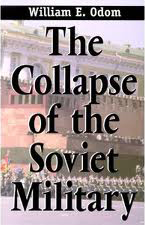 The Collapse of the Soviet Military
The Collapse of the Soviet MilitaryBy William E. Odom
New Haven, CT: Yale University Press, 1998)
404 pages
Reviewed by Steve Dunham
ANSER Transmissions, July-August 1999, copyright 1999 Analytic Services. Used by permission.
In this detailed book, William Odom, former head of the National Security Agency, describes why and how the Soviet military came apart.
Beginning in 1985, when he started trying to shift the Soviet economy from guns to butter, Premier Mikhail Gorbachev began eroding the military’s primacy in society. To garner support for his programs and overcome resistance within the government, Gorbachev promulgated glasnost (openness) and perestroika (restructuring). The resulting increase in public knowledge created opposition to abuses within the military, such as the hardships and even numerous noncombat deaths associated with a soldier’s life.
The change in public attitudes toward the military was accompanied by a loss of purpose within the military establishment. As early as the 1950s, under Premier Nikita Krushchev, Communist doctrine had shifted from worldwide class revolution (fostered by the Soviet military, which was geared for offensive war) to peaceful coexistence with capitalist nations (although the Communists continued to sponsor revolutions). Under Gorbachev the shift was more dramatic: the military’s purpose was redefined from offensive to defensive. This had a profound effect. Odom says that the Soviet military had never accepted the theory that mutual assured destruction would result from nuclear war (although the Soviet Union seems to have been deterred from starting one). On the contrary, Soviet military doctrine included use of tactical and strategic nuclear weapons. Soviet war plans for Europe included use of nuclear bombs to blast large gaps in NATO forces. Gorbachev’s new plan for a defensive military meant that large forces were not needed. He was willing to remove Soviet forces from Eastern Europe to reduce the military burden on the Soviet Union, and the military was coming to realize that the Soviet Union was in no danger of being invaded.
The military’s loss of purpose was paralleled by resurgent nationalism in the Soviet republics, which in the spring of 1990 began declaring independence. As nationalism began displacing Communism, Soviet officers started quitting the Communist Party—in which membership once had been required for advancement. Erosion of the Party’s status continued until Russian President Boris Yeltsin banned it in late 1991. Gorbachev’s
Some military leaders tried to preserve a joint military under the new Commonwealth of Independent States, particularly in the areas of air defense and strategic rocket forces. The republics, however, were unwilling to risk military domination again and refused to participate, effectively destroying the last vestige of the Soviet military.
Odom brings a thorough knowledge of Soviet affairs, the Cold War, and global geopolitics to his subject, providing not only authoritative commentary but also revelatory history.
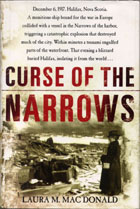 Curse of the Narrows
Curse of the NarrowsBy Laura M. Mac Donald
New York: Walker and Company, 2005
282 pp., $26.00 hardcover
Reviewed by Steve Dunham
Journal of Homeland Security, 2007. Copyright 2007 Analytic Services. Reproduced by permission.
On December 6, 1917, during World War I, in the Narrows of Halifax Harbor in Nova Scotia, Canada, the Belgian relief ship Imo collided with the French ship Mont Blanc, which was loaded with high explosives. The Narrows is a confined area, only a quarter mile across, and the Mont Blanc drifted up against a pier. The ship burned for
Although the disaster occurred
Individual initiative was prominent.
The tugboat Stella Maris had just passed the Imo going the other direction when the collision took place. The tug’s captain anchored the barges the tug was towing, turned his vessel around, and went to fight the fire with the boat’s single hose. Then he tried to get a line onto the Mont Blanc to tow it away from the shore. While attempting this, he and 18 of his crew were killed in the explosion.
“George Graham, president of the Dominion Atlantic
In Boston, banker James Phelan received Graham’s telegram requesting “a relief train” with all the “doctors, nurses, and Red Cross supplies” that could be obtained. Phelan called Henry Endicott, chairman of the Massachusetts Committee on Public Safety. They went to see Governor Samuel McCall, who sent his own telegram to the mayor of Halifax requesting more information. There was no reply. McCall didn’t wait any longer for confirmation—a trainload of medical supplies and volunteer doctors, nurses, and other medical workers left Boston that evening.
Closer cities and towns also sent relief trains. They all were needed. Hospitals were damaged or destroyed, and many first responders had been injured or killed, and in any case the sheer number of casualties overwhelmed local medical capacity.
At sea, the smoke cloud was visible
Besides initiative, other human behavior following the disaster was notable
After the explosion, many doctors and nurses first checked on their families—if the family members were still alive—then treated casualties nonstop for days.
With first responders overwhelmed, many untrained volunteers were accepted for work in the hospitals and aid stations. Many of the volunteers were themselves newly bereaved.
“The survivors displayed guilt because there was always someone who had lost more.” A characteristic that “appeared repeatedly” was “sufferers’ quiet acceptance.”
Not only volunteers turned out; there were problems with looting from the ruins and stealing from the dead.
Lack of communications caused problems
One trainload of victims was sent to Truro, Nova Scotia, but all the doctors there had been sent to Halifax. Two doctors and a nurse—all of the
People went from hospital to hospital and to the morgue in search of loved ones, and bodies remained buried in the rubble for days. Of the dead, 242 (more than a tenth) were never identified.
The newspapers resumed limited publication the day after the explosion, however, printing lists of the missing and dead, along with instructions from the city clerk’s office directing all survivors to register there and asking both the homeless and those who could accommodate them to file their names. A list of all hospital patients was printed in the papers as well.
Unpredictable factors affected response and recovery
The weather was erratic. Thursday,
Glass played a major role. The spectacular fire on the Mont Blanc was visible from many of the homes and other buildings on the hillsides surrounding the harbor. People stopped what they were doing to watch out the windows and were facing the glass when the ship blew up. Not just those standing by windows were hurt by flying glass, however. Almost all of the 6,000 people injured in the disaster suffered eye injuries.
With so many broken windows, the buildings still standing often had no protection against the cold. Glass was high on the list of relief supplies requested from outside the city, and those making repairs were urged to salvage any glass that could be used to mend even small windowpanes.
Military assistance was essential
At first, because Canada was at war, many people, including military personnel, thought the explosion was an attack rather than an accident. Within half an hour, though, the soldiers stationed in Halifax had joined the response to the disaster, distributing blankets, assisting firefighters, setting up tents, cooking meals, boarding up windows to keep out the winter weather, and more. Convalescing soldiers left their beds at the military hospital to assist. “Three days after the explosion, the Canadian
“The USS Old Colony, an American passenger steamer that the
On the other hand, the absence of many husbands and fathers affected the surviving families. One-tenth of Canadian men were away at war, and in Nova Scotia, nearly a fourth of the men were in the military.
The war was responsible, however, for the existence of many organized volunteers: there was a Voluntary Aid Detachment of the
The scope of the catastrophe made recovery especially difficult
Just burying the dead was an enormous task. Dozens of soldiers and volunteers spent two weeks digging graves, but it was not enough. Clergymen had an impossible workload conducting funerals: one church lost
Many people were without jobs, homes, food, or furniture. Some were able to leave the city and live with relatives, but many families spent the winter living in one room.
The following year, what was left of the neighborhood of Richmond—the devastated area by the Narrows—was razed and redeveloped.
A timeless story
Laura Mac Donald, a Halifax native, has written a vivid piece of history (some parts may be too vivid for the squeamish reader). Combing through the official records—some of which had lain untouched since 1918—she put together a historical narrative with compelling facts as well as personal stories that will keep the memory of the Halifax explosion alive for another century.
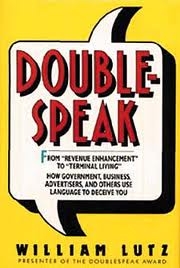 Doublespeak
DoublespeakBy William Lutz
New York: Harper & Row, 1989
269 pp.
Reviewed by Steve Dunham
ANSER Transmissions, May-June 2000, copyright 2000 Analytic Services. Used by permission.
Are you annoyed by “necessary conditions that must be met,” “savings events” where you can buy “processed food products,” or educators who propose “inquiry-centered critical-thinking strategies”? You have good company in William Lutz, who created the annual Doublespeak Award and the Quarterly Review of Doublespeak.
In his book, Lutz defines four kinds of doublespeak: “euphemism, an inoffensive or positive word or phrase used to avoid a harsh, unpleasant, or distasteful reality”; “jargon, the specialized language of a trade, profession, or similar group”; “gobbledygook or bureaucratese … a matter of piling on words, of overwhelming the audience”; and “inflated language that is designed to make the ordinary seem extraordinary.” While the author acknowledges that euphemism and jargon have their place, he opposes the use of language to deceive or that wallows in pomp but fails to communicate.
Jargon, for example, can be “pretentious, obscure, and esoteric terminology used to give an air of profundity.”
Doublespeak is language that “attempts to avoid responsibility and make the bad seem good, the negative appear positive, something unpleasant appear attractive; and which seems to communicate but doesn’t. It is language designed to alter our perception of reality and corrupt our thinking.”
Sometimes the education system breeds doublespeak. “An article in a scholarly journal suggests teaching students three approaches to writing to help them become better writers: ‘concretization of goals, procedural facilitation, and modeling planning.’” If the teachers are writing like that, no wonder the students can’t write well.
He hits the easy bull’s-eye of education jargon,* but in some places Lutz demands too much. A “direct flight” should be nonstop, he insists, and cheese and crackers or a package of peanuts do not constitute a “snack,” in his opinion.
In other places he is right on target, as when he decries the airline term “preboarding process”: “I live for the day when I will see someone actually ‘preboard the equipment.’ I want to see someone actually board the airplane before boarding it, and I want to see the process someone has to go through in order to preboard.”
Naturally, Washington, DC, where obfuscation is practically an art form, does not escape Lutz’s attention. He gives examples of how charts can be used to deceive, reprinting two that distort the numbers they purport to illustrate, including one used by President Reagan on TV—it showed only the top of a chart and compressed the time scale to give sharp peaks and lots of space between two lines that, when all the data were shown, were actually close together.
Not surprisingly, the Pentagon takes it on the chin in this book, with Lutz citing outlandish euphemisms and
Vapid terms are his targets too: “‘Process’ lost its luster, so another meaningless yet impressive word had to be found. Some genius at doublespeak came up with ‘initiative’”—the word to use for anything “that is more goal than fact, more hope than reality, more hype than substance.”
The book has drawbacks, however: a lot of material is cited more than once, and the author’s commentary on doublespeak usually consists of sarcasm; 269 pages of doublespeak and sarcasm can make for tiresome reading.
 |
by William Strunk Jr. and
New York: Penguin, 2005
142 pp.
Reviewed by Steve Dunham
During my senior year in high school, our honors English class had one textbook:
In recent years, though, the book has been criticized as stuffy, pedantic, and excessively prescriptive. As an editor, I give first aid to writing, and even though I’m not a doctor, I occasionally write prescriptions for writing that needs it. I’m not against a prescriptive approach to writing and editing. There are, as the authors phrase it, some “experts in the art of bad writing,” and for them prescriptions are in order.
A few years ago, a friend gave me a copy of
The Elements of Style holds up well if you are willing to take advice from professionals such as Strunk and White. In
However, much of the book is devoted to rules, and some of them, such as when to use shall and will, indeed are stuffy, pedantic, and excessively prescriptive. Sometimes the authors appeal to Latin as a standard (I was taking Latin in my senior year of high school too), but Latin is not a good guide to English usage.
Also, some of the new material became outdated faster than the original text: “By the time this paragraph sees print, psyched, nerd, ripoff, dude, geek, and funky will be the words of yesteryear,” they wrote; that prediction was totally wrong, as
Finally, “Maira Kalman’s whimsical paintings,” as the
My conclusion, after more than
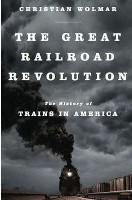 |
By Christian Wolmar
New York: Atlantic Books, 2011
359 pages; maps, illustrations, index, $29.99 hardcover
Reviewed by Steve Dunham
This review originally appeared in the Fredericksburg, Virginia, Free Lance–Star on
British author Christian Wolmar has written a “concise history” of how railroads transformed America and America transformed the railroads. He takes us from the railroads’ beginnings in the 1830s through their dominance in the early
His “selective approach” includes the most important events and people: inventors, robber barons, settling the West, national commerce and industry, the railroads’ losing battle to subsidized highways and aviation and a rebirth with deregulated freight railroading and some government sponsorship of passenger service as aviation and highways approached their limits.
The journey begins with America’s first railroads: cars hauled by animals on wooden rails, replaced, in the 1840s, with steam power and metal rails. The competition—canals and turnpikes—was mostly unprofitable, and railroads provided year-round transportation that revolutionized mass production and expanded the markets for agriculture.
They didn’t always do this on their own, however. The railroads were not “an entirely private enterprise,” notes Wolmar. State support was often needed. Construction labor was often in short supply; the South used slaves and convicts, with a high mortality rate.
Early lines usually connected ports with hinterlands. The first long railroad—over 400 miles—was the Erie, connecting the Hudson River to the Great Lakes; it was also the first to use the telegraph.
By 1860, the United States had 30,000 miles of railroads, more than the rest of the world put together, but they were mostly unconnected lines with little through service, and variations in gauge (distance between the rails) hindered long hauls.
During the Civil War, “the railroads afforded the armies unprecedented mobility”—they could “operate much farther from their supply depots,” giving “the side with the best railroad supply line a clear strategic advantage.” Southern states had issued only intrastate railroad charters; the resulting lack of connectivity and assorted gauges interfered with the railroads’ military use. Overall, the war benefited Northern railroads but ruined many Southern ones.
Afterwards, the railroads kept growing. Mileage doubled again and again. The most dramatic expansion was the “transcontinental railroad,” completed in 1869. Not really transcontinental, it filled a huge gap to create a coast-to-coast network. It involved extraordinary corruption; the infamous Crédit Mobilier scandal made Union Pacific Railroad officials rich through rigged contracts.
Elsewhere, railroad speculation created unneeded lines that didn’t repay investment, triggering the financial panic of 1873. Railroads cut wages, leading to the 1877 strikes, which were violently put down by militia.
Another financial panic hit in 1893, and 89 of 364
With the railroads’ dominance came improvements, such as through service and dining and sleeping cars. The railroads adopted standard gauge and standard time; knuckle couplers and air brakes made trains safer to ride and operate.
But as the railroads grew in size and power, they lost public favor. Wrecks contributed to the anger. Gangs robbed trains, often with public sympathy. The Grange and the Farmers’ Alliance battled railroad power, and the unions grew stronger.
As America entered the 20th century, railroads kept growing, but their power started to recede. World War I saw a temporary federal takeover of the railroads, which—blocked partly by antitrust legislation—cooperated so little that unloaded freight cars clogged ports.
Regulation of rates limited railroads’ ability to make a profit and to modernize—they were “constrained … by the rules that their own past misbehavior had brought about.” Other competition appeared: streetcars and intercity trolleys.
“Incoherent regulation, government policies, and subsidies favoring rival modes of transportation conspired to begin the shift from a national rail-based transportation system to one dependent on the roads, a process that” took “little more than a generation.”
In the 1920s and 1930s, automobiles captured much passenger business; trucks, unregulated until 1935 and operating on federally funded highways, captured some of the freight. Many rail lines were abandoned.
Yet “the Second World War demonstrated that the railroads were still the backbone of the nation’s transportation infrastructure. Aviation was still a minority activity, and the roads … were not only inadequate but also just too slow for the carriage of large quantities of men and materiel.”
After 1945, U.S. railroads declined as they lost business to highways and air travel.
New diesel engines were cheaper to operate than steam, requiring fewer crew members, for one thing, but unions fought to retain jobs and the antiquated
Many railroads sought financial relief through mergers. The biggest merger was the Penn Central: two historic rivals, the Pennsylvania Railroad and the
Meanwhile, the railroads insisted on ending their financial losses from passenger trains. The solution, in 1971, was Amtrak, which retained extensive service in the Northeast, where large numbers traveled by rail, and a minimal network in the rest of the country.
Amtrak was supposed to be profitable, but “profitability
Relieved of passenger trains, many railroads still struggled, but cutting freight service and closing lines didn’t generate enough savings and generated no revenue. The rescue came in two forms: Conrail, a 1976 government-funded consolidation of six bankrupt Northeast railroads, and the Staggers Act of 1980 that largely deregulated freight operations. Well-managed railroads could make money again, and even Conrail turned a profit. Today
With highways filling past capacity and obliterating parts of cities, with parking eating up valuable urban real estate, plus pollution from so many motor vehicles, many
The book’s journey ends with
The book is easy and enjoyable to read. Wolmar knows railroad history, government policies and the economics of transportation. He uses American English, though some British terms remain: chimneys (locomotive smokestacks), halts (stations), wagons (railroad cars). He also gets some facts wrong, particularly involving the Civil War.
As a concise history of American railroads, though, it’s an interesting trip.
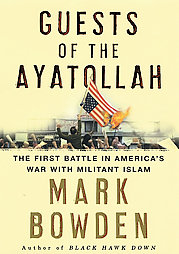 Guests of the Ayatollah
Guests of the AyatollahBy Mark Bowden
New York: Atlantic Monthly Press, 2006
637 pp., $26 hardcover
Reviewed by Steve Dunham
Journal of Homeland Security, 2006. Copyright 2006 Analytic Services. Reproduced by permission.
Bowden describes the
With the hostages hundreds of miles from friendly territory, rescue seemed impracticable, because a military mission that did not reach them stealthily might result in the hostages’ execution before help arrived. With the United States unwilling to return the Shah, the hostage-taking quickly devolved into a stalemate. Within Iran, however, it was part of the struggle that consolidated the power of Iran’s Ayatollah Khomeini.
Six Americans escaped the embassy during the takeover and got out of the country. After two weeks,
The Iranians were convinced that the embassy staff “was engaged in a massive spy operation intent on stopping the revolution, killing Khomeini, and restoring the” Shah to power, writes Bowden. There were three CIA agents among the staff, engaged in “routine, prudent espionage conducted at diplomatic missions everywhere.” In fact, says the author, the CIA work in Iran at the time was notably ineffectual, gathering little information and hampered by the fact that none of the agents spoke the local language, Farsi.
The hostage-takers themselves were not soldiers or government thugs. They were mostly students who had dropped out of school to join the revolution, and they had to fight off rival factions to maintain their hold on the embassy. Although convinced that the embassy was a center of opposition to the new government, they were not always hostile to the Americans, claiming that hostages were actually guests of the Ayatollah. Their guests experienced long periods of solitary confinement and for months were forbidden to speak to one another.
In April 1980, a rescue attempt by the
While the embassy staff remained prisoners, Iraq attacked Iran, and because of the war, which would last eight years, Iran needed parts for the military aircraft it had purchased from the United States before the revolution. Iran also had billions of dollars in assets tied up in the United States, frozen by President Carter. By late 1980, the Shah was dead, and Iran began negotiating for release of its funds and release of the hostages but stalled till Carter was out of office—ironically, because Carter’s policy of restraint would have evaporated under Reagan.
Based on dozens of interviews with the hostages, Iranians, rescuers, the hostages’ families, and others, Bowden has succeeded in telling the story of the hostage crisis as lived by those who were part of it. In a few places he digresses from recording history to inject his own comments, calling the rescue attempt “military ineptitude” and a “ham-handed invasion” and asserting that “God speaks to very few, if any of us.” Such opinions would have been better saved for a talk show, but they are few, and Bowden has produced a readable chronicle.
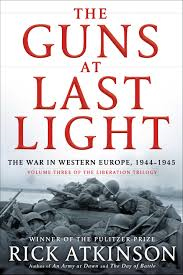 The Guns at Last Light: The War in Western Europe,
The Guns at Last Light: The War in Western Europe, By Rick Atkinson
New York: Henry Holt & Co., 2013, with index, photos, and maps.
Reviewed by Steve Dunham
This Pulitzer Prize winner gives a vivid account of the Allied ground war in Europe during the last two years of World
Like the two previous books in the Liberation Trilogy, this one combines the big picture with close-ups of personal experiences, and like the others it is sometimes marred by poor word use (gambit, for example, which is not just an opening move in chess but one that sacrifices a piece,* and emulate, which means not just to imitate but to equal or exceed), occasional bad grammar (“The immediate objective of DRAGOON
Worse, in this book, Atkinson frequently quotes profanity, making the text not only offensive but less emphatic, because nowadays profanity is common not just in dire circumstances but to express annoyance over small inconveniences. About two-thirds of the way through the book, I almost abandoned reading it.
Also, in some places that deserve a citation, there is lame attribution, such as “so it was said.” There are lame comparisons too: “smaller than Oregon,” but how many readers know how big Oregon is? Or “more Yanks than lived in all of Nebraska,” but outside a few cities in the eastern part of the state, Nebraska doesn’t have a lot of Yanks, being sparsely populated farm country.
He also tosses in some schoolboy humor, referring to “Charlemagne’s royal posterior”; if Charlemagne’s throne doesn’t deserve respect, Atkinson should say why, not just make fun of it.
The book was worth reading, I suppose, but I wouldn’t give it any prizes.
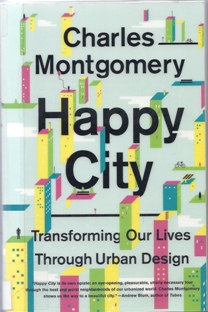 Happy City: Transforming Our Lives Through Urban Design
Happy City: Transforming Our Lives Through Urban DesignBy Charles Montgomery
New York: Farrar, Straus & Giroux, 2013
319 pp., $27 paperback
Reviewed by Steve Dunham
Montgomery argues that our happiness is greatly influenced by our environment and that changing our cities will make people happier. He starts with Bogotá, Colombia, and its mayor at the time, Enrique Peñalosa, who instituted el dia sin carro: the day without cars. The occasional event brings city residents of every class onto the streets on foot and on bicycle, while business goes on and schools remain open. Peñalosa rode his bicycle to a school to meet his son, and they rode home together on their bicycles on streets free of motor traffic. “Can you imagine if we designed the entire city for children?” asked Peñalosa
Although Peñalosa knew “that the redistribution of privilege always meets with
Martha Delgado, Mexico City’s “environmental secretary until 2002, told [Montgomery], ‘A city that lives under the hostility and insecurity of car traffic can change only if its citizens retake ownership of its public spaces’”
“The good city should be measured not only by its distractions and amenities but also by how it affects [the] everyday drama of survival, work, and meaning,” writes Montgomery
“Even though the modern cosmopolitan city makes it easier than ever for individuals to retreat from neighbors and strangers, the greatest of human satisfactions lies in working and playing cooperatively with other people”
No age in the history of cities has been so wealthy. Never before have our cities used so much land, energy, and resources. Never before has the act of inhabiting a city demanded converting so much primordial muck into atmosphere-warming gas. Never before have so many people enjoyed the luxury of private domesticity and mobility. Despite all we have invested in this dispersed city, it has failed to maximize health and happiness. It is inherently dangerous. It makes us fatter, sicker, and more likely to die young. It makes life more expensive than it has to be. It steals our time. It makes it harder to connect with family, friends, and neighbors. It makes us vulnerable to the economic shocks and rising energy prices inevitable in our future. As a system, it has begun to endanger both the health of the planet and the well-being of our descendants.Our challenge [lies] in the way we build, but also in the way we think. It is a design problem, but it is also a psychological problem. It lives in the tensions that exist within each and every one of us—that endless tug-of-war between fear and trust, between status aspirations and the cooperative impulse, between the urge to retreat and the need to engage with other people. As much as they embody a philosophy of living, cities also reflect our cognitive frailties, and the systematic errors every one of us tends to make when deciding what will make us happy in the long run
[p. 315].
“What should a city accomplish after it meets our basic needs of food, shelter, and security?” (The answers are quoted from the book,
He notes that zoning has divided many cities, especially suburbs, in ways that force people to leave their neighborhoods for many needs and reduces spontaneous interaction. “Functional segregation was built into almost every new suburb after World
Furthermore, in “many North American
When he lived in Vancouver, Montgomery had an apartment in a tower with hundreds of other residents. This was isolating, as random encounters in the hallway or elevator involved people he might never see again. Later, he lived in an a garden apartment very close by, where the smaller number of neighbors encountered one another often and shared a social life.
People who say they feel that they “belong” to their community are happier than those who do not.And people who trust their neighbors feel a greater sense of that belonging.
And that sense of belonging is influenced by social contact.
And casual encounters (such as, say, the kind that might happen around a volleyball court on a Friday night) are just as important to belonging and trust as contact with family and close friends
[p. 134].
Extrinsic happiness—happiness based on things—is always a moving goal line, he says. The happiness wears off and a new goal appears to offer happiness. Intrinsic happiness, though—happiness based on home, family, and relationships—brings contentment
We also tend to assume that things will always be the way they are now and “that the ways we think and act will not change as time passes”
The sustainable city has got to promise more happiness than the status quo. It has got to be healthier, higher in status, more fun, and more resilient than the dispersed city. It has got to lure us closer together rather than pushing us apart. It has got to reward people for making efficient choices when they movearound.… This city is already being
born …
The happy city also must provide easy contact with nature. “Nature is not merely good for us. It brings out the good in us”
Vancouver now allows basement suites and conversion of buildings on garage lanes into small houses, comfortably increasing population density
But “there is no perfect neighborhood for everyone. We all have our own tolerance for crowding or quietude, our own thirst for novelty or privacy or music or gardening, and our own complex associations with places, scents, and memories. But the systems in which we live undeniably influence our emotional lives”
He cites the public plazas built in Manhattan following a 1961 ordinance allowing higher buildings in return for creation of public space. A lot of the spaces created were intentionally hostile to people.
“In the fair city, streets are safe for everyone, especially
“In the fair city, everyone has access to parks, shops, services, and healthy food.
“This access is almost never realized by accident”
“It’s not enough to nudge the market toward equity. Governments must step in with subsidized social housing, rent controls, initiatives for housing cooperatives, or other policy
“The Bogotá experiment may not have made up for all the city’s grinding inequities. But it was a spectacular
“Sadly, Bogotá’s fortunes have since
“But Bogotá’s transformative years still offer an enduring lesson for rich cities. By spending resources and designing cities in a way that values everyone’s experience, life can get easier and more pleasant for everyone. We can make cities that are more generous and less cruel. We can make cities that help us all get stronger, more resilient, more connected, more active, and more free. We just have to decide who our cities are for. And we have to believe that they can change”
Peñalosa’s campaign in Bogotá was not planned with environmental protection in mind. But “after making Bogotá easier, cleaner, more beautiful, and more fair, the mayor and his city started winning accolades from environmental organizations”
For the most part, the book is informative, thoughtful, engaging, and generally convincing, even if a lot of the evidence is anecdotal. Sometimes, though, the author gets bossy and self-righteous: “If you don’t give a damn about the environment or your descendants, then feel free to skip to the next chapter. Just remember that the urban innovations I will later propose in the name of happiness may also save the world”
There’s more wrong with the world than the way cities are designed. The seven deadly sins aren’t all caused by the built environment. Still, as Peter Maurin said, we can aim to create an environment in which it is easier to be good.
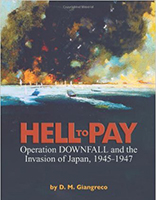 Hell to Pay: Operation DOWNFALL and the Invasion of Japan, 1945-1947
Hell to Pay: Operation DOWNFALL and the Invasion of Japan, 1945-1947By D. M. Giangreco
Annapolis, MD: Naval Institute Press, 2009
204 pp., plus appendices: an
Reviewed by Steve Dunham
Drawing on Allied and Japanese sources, the author details their plans for the upcoming battle. The Japanese deduced that the invasion would come in fall 1945, initially against southern Kyushu and later the Kanto Plain around Tokyo. The invasion dates for Honshu were limited by the weather. The Japanese planned to build up reinforcements on Kyushu before the island was isolated. “Both sides were rushing headlong toward a disastrous confrontation in the Home Islands”
Japan’s situation, as revealed through Ultra sources, suggests [that] her unwillingness to surrender stems primarily from the failure of her otherwise capable and all-powerful Army leaders to perceive that the defenses they are so assiduously fashioning actually are utterlyinadequate.… Until the Japanese leaders realize that the invasion cannot be repelled, there is little likelihood that they will accept any peace terms satisfactory to the Allies.
—Naval Intelligence analysis in “‘Magic—Diplomatic Summary,’ 1945”
The author makes a convincing case that the estimates of a quarter million to
Of the 1.25 million U.S. combat casualties in World
The United States planned to shift
The author also notes that Japan had many pilots and aircraft and much fuel in reserve to combat the invasion, though fuel for training was severely rationed. The pilots with little training would have been sent on suicide missions. The Japanese had hundreds of suicide boats, but “successful attacks” were “far from commensurate with their large numbers” in earlier campaigns, noted the
The Japanese also planned to shift divisions from Manchuria to the homeland to resist the invasion. They hoped to make the invasion so costly that the Allies would negotiate a peace. Yet each Japanese division on Kyushu “was to have enough” ammunition “for 0.6 to
His argument that civilians armed with bamboo spears would have been a threat is not convincing; he says that “the real danger in the type of tactical situation faced on Kyushu would come from a comparatively small number of well-armed regulars directing and supporting a willing population armed with spears, swords, and cheaply produced firearms”
This is a book full of numbers, but some are puzzling. He says, for example, that the 14,253-man
The author claims that in January 1945 Truman was “engaged each and every day as” president of the Senate, the Vice President’s role
The book has doubtful statements: that
Worse, the author deviates from history to indulge in sarcasm and insults. Apparently some historians dismissed veterans’ claims of high casualty forecasts because the veterans could not remember where they heard the numbers. Giangreco says that the “inconsiderate” young men “inexplicably failed to take detailed notes”
The author seems to have a problem with plurals: eleven month before
The book also has many problems with the quotations—ironic coming from somebody who accuses others of sloppy scholarship. General Willoughby is quoted on the same page
The book also contains a distressing number of typos and errors in word usage: for example, Capital Hill instead of Capitol Hill
 How I Survived My First Year of Full-Time Self-Employment: Going It Alone
How I Survived My First Year of Full-Time Self-Employment: Going It Alone By Liz Broomfield (now Dexter)
Self-published, 2013. 91 pp. with appendices
This book’s format came as a pleasant surprise: it’s a monthly diary, followed by appendices. I was expecting a book full of rules and suggestions based on lessons she learned—it has all that, but it’s presented as a story. From the introduction:
“There are a lot of secrets in business—
Liz invites you to take a walk with her through the year, encounter the ups and downs with her, and learn the lessons as she learns them. She hopes that the “journey will inspire others to do it the safe and calm way.” As she says, “Self-employment doesn’t have to mean scary entrepreneurship.”
It does get rough at times. Liz was going to call her networking group the Café of Pain. But her motto is “Keep calm and carry on.”
She established her business, LibroEditing, with what she calls a “soft launch”—going from full-time library employment to part-time, “then even more part-
And she didn’t need to get a full-time income out of Libro immediately once it became her only job: she built up some savings while still employed and getting the business going.
After the plunge into full-time self-employment in December, she presents diary entries for the following year. We learn with her about marketing; having too much work, having too little, and what to do about it; whether to take risks; and more. “Managing expectations is all very well, but these clients need the work quickly, and I can’t make infinite deadlines for my less urgent clients: their work has to be done at some time!”
Liz describes her methods for scheduling work and keeping accounts, knowing that readers will need to devise their own ways of organizing pieces of a business, and simply offers her ways as an example. Her description of how she handles her bookkeeping will encourage you to do yours promptly and regularly, even if your system is different. If you’re self-employed, or thinking about it, just reading how she does things will probably give you ideas for your own business.
A section on social media and networking has useful information. Liz talks too about motivation and setting goals for yourself.
In a few places there might be too much detail for some readers. Liz mentions a lot of the work she did and where it came from, and she devotes a couple of pages to what she wears while working and a couple more to tea.
Near the beginning she presents a typical week before she went to full-time self-employment. It summarizes her schedule and is a bit dry to read, but it conveys the busyness of trying to juggle a job and a business.
Liz is British, and she occasionally uses some terms that will be foreign to us North American readers. I figured that Inland Revenue must be a regulatory agency and the C in HMRC probably stands for college (she registered with the first and took a course with the second). Nope: both Inland Revenue and HMRC (Her Majesty’s Revenue and Customs) are tax-collection authorities. But, differences in government and terminology notwithstanding, her description of how she handles her taxes present practical ideas that work in the USA. I too subtract the tax from self-employment income I receive and put it aside until it’s due.
The story of her first year of full-time self-employment ends with a look back—two looks, actually: one in December and one four months later, when she considered Libro a mature business.
The appendices help the reader “how to decide whether to go self-employed, how exactly to do it, and [offer] some other useful hints and tips.”
If you’re thinking about self-employment, you could benefit from talking with somebody who is successfully self-employed. This ebook comes pretty close to that: it’s personal and informative. You can see how Liz did it, what went wrong and what went right, and even how she felt about it.
This whole ebook is included in Your Guide to Starting and Building Your Business.
You can buy Liz’s books at http://lizbroomfieldbooks.com/.
Her LibroEditing blog, which I read avidly, is at http://libroediting.com/blog/ and has links to still more of her online writing.
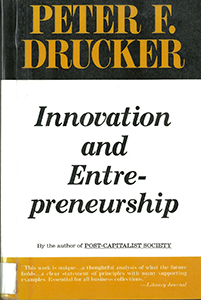 Innovation and Entrepreneurship
Innovation and EntrepreneurshipBy Peter F. Drucker
New York: HarperBusiness, 1985
266 pp., softcover
Reviewed by Steve Dunham
“The entrepreneur always searches for change, responds to it, and exploits it as an opportunity,” wrote Drucker
Entrepreneurship exploits seven source areas, wrote Drucker (quoted from p. 35):
Drucker commented on “The unexpected failure”: “If something fails despite being carefully planned, carefully designed, and conscientiously executed, that failure often bespeaks underlying change and, with it, opportunity”
Companies, he said, may not recognize change and how to exploit it. They often focus on the cost of operations. He advised to concentrate instead “on the costs of not working”
Another mistaken focus he cited is “values or expectations the producer or supplier holds” that “are incongruous with the values and expectations of customers and clients”
And innovation and entrepreneurship apply not just to commerce, he wrote. “Public-service institutions have both an opportunity and a responsibility to be entrepreneurial and to innovate”
“The ultimate purpose of a business, indeed, of economic activity,” wrote Drucker, is to “create a customer,” which is done in four ways (quoted
“To start out with the customer’s utility, with what the customer buys, with what the realities of the customer are and what the customer’s values are—this is what marketing is all
“Conclusion: The Entrepreneurial Society” is the book’s weakest chapter: Drucker’s opinions on how to promote growth in jobs and capital and to shrink the welfare state. In it he goes from being a paid consultant to companies to being an uninvited consultant to society, the nation, and the world.
On the whole, though, the book is well written and interesting, and relevant even
 Islam: A Mosaic, Not a Monolith
Islam: A Mosaic, Not a MonolithBy Vartan Gregorian
Washington, DC: Brookings Institution Press, 2003
135 pp., $15.95, softcover
Reviewed by Steve Dunham
Journal of Homeland Security, 2007. Copyright 2007 Analytic Services. Reproduced by permission.
Gregorian’s book is not brand new, but it is timely. It introduces us to the facets of the Islamic mosaic, which has pieces throughout the world and is embodied in microcosm by the diverse Muslim communities in the United States.
His book is brief, but not shallow. Its encyclopedic view of Islam is well written and readable, but dense with information.
The Muslims he writes of are our fellow citizens, our world neighbors, and, yes, sometimes our enemies. But they are not a monolith.
“Throughout Islamic history, the gravitational pull of regional, dynastic, and since the nineteenth century nationalist interests has consistently outweighed the spiritual affiliations of some idealized, transcendent, organic umma [Muslim community],” writes Gregorian, president of Carnegie Corporation of
Islam’s “ancient divisions, conflicts, and
However, the “militant Islamists” do “dream of a Pan-Islamic movement that will create a single Muslim umma under a single Caliphate, or one authority, ruling from the Atlantic Ocean to the China Sea.”
The reality of Islam in the
Islam as a religion is broken into factions. “Early divisions in Islam ultimately resulted in scores of Muslim denominations.” The major branches are Sunnis, Shii, and Sufis. “The Sunnis represent the overwhelming majority of Muslims, but Sunni doctrine has long been a source of dispute”—especially its rational theology and belief “that the Qu’ran was man-
Conflict—sometimes bloody—between Sunnis and Shii stretches back more than a thousand years.
Another division in Islam is between modernism and traditionalism. The modernists look to Islam’s history of scientific and cultural achievement and believe that Islam should adapt to the modern world, while traditionalists seek an Islamic revival based on age-old precepts.
Islamist parties “promote Islam as an ideology in a theocratic state,” whereas Islamic parties “want secular political systems to reflect the moral principles of their religion.” Both want their religion embodied in law, and this leads to conflict between Muslim factions and, in Muslim states, between the Muslim majority and the religious minorities.
Even outside the Muslim nations, religious intolerance is a major problem among Christians, Jews, and Muslims. It is “clear that Muslim societies are as ignorant of our society as we are of theirs.”
“The challenge before us all—Muslims and non-Muslims, in America and around the world—is one of understanding and accommodation: how can each group maintain and develop its own set of values and at the same time coexist and interact with other systems, religions, and cultures? One hopes that out of dialogue will come understanding and respect, and out of respect will come
 James Madison
James MadisonBy Richard Brookhiser
New York: Basic Books, 2011
250 pp.
Reviewed by Steve Dunham
A well-written biography, though a bit brief; I wished for more on his years as president.
Madison was not only father of the Constitution but father of American politics, founding, with Thomas Jefferson, the Republican Party, ancestor of today’s Democratic Party.
Madison believed fervently in religious liberty. He wanted people to enjoy not just religious tolerance—permission to worship freely—but the right to worship freely. “Toleration is a gift,” writes Brookhiser; “truly free men exercise their rights”
He was elected to the Virginia Assembly in 1776 and, with George Mason, wrote the Declaration of Rights.
Meeting in Annapolis in 1786 to discuss interstate navigation, Madison and Alexander Hamilton, lacking a quorum, wrote a call for a constitutional convention the following year. Madison spent the intervening months studying governments and went to the convention with a plan. One objection to his plan was that large republics had been rare, but Madison was convinced that a republic was the right form of government for the United States. Madison recognized that the real division was not between large and small states but between North and South. Madison kept notes of the convention’s deliberations, not just motions and votes as the secretary did. These he withheld to be published posthumously. Mason insisted on a bill of rights in the Constitution, and only these first ten amendments made possible its ratification.
Madison also wrote some of Washington’s words for him, including the inaugural and farewell addresses.
The XYZ affair (involving three Frenchman identified in a letter to America as X, Y, and Z who sought bribes from American delegates) bred hostility toward France, and during a subsequent undeclared war, the Alien and Sedition Acts were passed by the Federalists and signed by John Adams; the laws were set to expire at the end of his term. Adams’s administration never enforced the Alien Act, but there were
These laws and the hostility toward France bred resentment in Francophiles Madison and Jefferson, who then started organizing Republicans. Although Madison and Jefferson were among the authors of the Federalist Papers, by this time the Federalists were an organized force antipathetic to Republican principles.
Partly to prevent the Federalists from getting even one electoral vote in Virginia, Madison got the Virginia electoral law changed to winner take all.
Thomas Jefferson and Aaron Burr tied in the 1800 election. It fell to the House of Representatives to decide the election, but the House too was tied. One Representative relented on the
Madison and Jefferson got France, short of cash, to sell Louisiana, and tried to get France to force Spain to sell the Florida panhandle. Spain and France both refused. Later, in 1810, Madison, by presidential proclamation, annexed the Florida panhandle—simply took it from Spain.
In response to British impressment of American sailors and to British and French embargoes on
A false thaw in relations with Britain was followed by strict British restrictions
Madison defeated Monroe in the contest for the Republican nomination, but after becoming president in 1811, Madison patched things up with Monroe. Afterwards he replaced Secretary of State Robert Smith with Monroe.
In 1811, Congress imposed the Non-Intercourse Act, allowing American trade only with neutral countries. France said it would revoke its restrictions on trade if Britain did, but Britain would not. Also in 1811, the charter of the Bank of the United States expired, making it harder for the
During the British invasion, the Secretary of War obstructed Madison by inaction. Madison himself went to the battlefield at Bladensburg.
In late 1814, fed up with the war, but just before the battle of
He longed for an end to slavery, but did nothing. Madison’s “solutions to the problem of slavery were worthless, a pathetic case of intellectual and moral failure,” writes Brookhiser
Both James Madison and James Monroe were protégés of Thomas Jefferson, forming the “Virginia Dynasty” in the White House.
I visited his home Montpelier last year, and this book added much to my knowledge of James Madison.
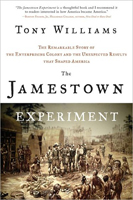 The Jamestown Experiment
The Jamestown ExperimentBy Tony Williams
Naperville, IL: Sourcebooks, 2011, 257 pp.
Reviewed by Steve Dunham
Williams recounts the history of the Jamestown colony, citing mostly secondary sources plus some colonial records such as journals, saying that Jamestown is where the American Dream was born.
The initial voyage employed men only, in a military-style organization. It made landfall at Martinique. After stops at Caribbean islands, one of the captains wanted to go back to England when Virginia was not found promptly. They picked Jamestown because it was far enough upriver to remain undetected by any passing Spanish cruisers.
The colonists hoped to find gold and the Northwest Passage but found little of the former and, despite Indians’ statements that a great body of salt water lay only four or five days’ journey to the west, no sign of the Northwest Passage.
The colonists’ relations with the Indians were initially a combination of confrontation and trade but degenerated over the years into mostly confrontation.
Although the colonists arrived in spring, a propitious time for planting, and the area had game and fish, the settlers soon ran low on food and fell prey to summer diseases.
John Smith already had a history of adventurism and was arrested en route as a mutineer. After landfall in Virginia in 1607, he was freed, but not seated on the governing council according to the original plan. A year later, he was elected council president and instituted a regime of discipline, but the colonists continued to be hungry.
During a visit with the Indians, Pocahontas appeared to save his life from her tribe but it was probably a ceremony.
Over the following years, ships brought more colonists, who became extra mouths to feed. One ship caught in a 1609 hurricane fared the best: the colonists were shipwrecked on Bermuda, which despite an evil reputation turned out to be a pleasant place where it was easy for the people to feed themselves. They later named Virginia’s Bermuda Hundred (a subdivision to sustain
In June the surviving settlers abandoned Jamestown, intending to sail for Newfoundland, but at Point Comfort they were turned back by Del
Gates, an earlier governor, returned in 1611, with hundreds more colonists, bringing the total to about 750. Around this time Samuel Argall, with the help of the Patowmecks, kidnapped Pocahontas, who was held captive, educated, and eventually brought to England, where she died.
The colony’s economy turned around when tobacco became a profitable export. If colonists raised two acres of corn, with some of it contributed to the common store, they could also grow and sell as much tobacco as they desired. Otherwise all the tobacco they grew was forfeit to the government. From this time onward the colony sustained itself with food and profits, though not all were wealthy, and some continued to go hungry.
Self-government was instituted with the establishment around 1617 of the House of Burgesses. By 1622, the colonists were generally at peace with the local Indians until an Indian was murdered, provoking a massacre of
Besides recounting the history, Williams makes a point over and over: Jamestown was founded by free, entrepreneurial Englishmen, and the “capitalist and entrepreneurial
While the entrepreneurs get repeated shout-outs, the slaves are barely mentioned, and Williams says that they were
Besides the distracting pro-capitalist interjections, the book has lot of errors in word use: comprise misused often; “burning cords” emulating “soldiers firing their muskets”
Although it is mostly a second-hand story, short on original research, with better editing and by sticking to history instead of propaganda, this could have been a good book.
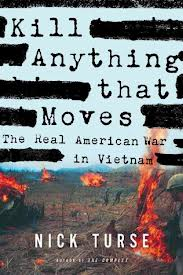 Kill Anything That Moves: The Real American War in Vietnam
Kill Anything That Moves: The Real American War in VietnamBy Nick Turse
New York: Metropolitan Books, 2013
262 pp.; maps, index, illustrations
Reviewed by Steve Dunham
The
included more than300 allegations of massacres, murders, rapes, torture, assaults, mutilation, and other atrocities that were substantiated by army investigators. They detailed the deaths of137 civilians in mass killings, and78 smaller- scale attacks in which Vietnamese civilians were killed, wounded, and sexually assaulted.
Numerous veterans confirmed to Turse that “Kill anything that moves” was not an unusual order and that many villages shared
“The key elements at” the 1967 killing of
Angry troops primed to lash out, often following losses within the unit; civilians trapped in their path; and officers in the field issuing ambiguous or illegal orders to young men conditioned toobey …
The chapter “A Litany of Atrocities” lists half a dozen incidents similar to
According to the rules of engagement, “villages could be attacked” if the civilians failed “to evict armed guerillas” (Turse’s words), although the army’s official policy prohibited attacking civilians. In 1962, Brigadier
“In a confidential 1967 message,” Marine Corps “Lieutenant General Robert Cushman wrote: ‘To answer sniper fire from a hamlet or village with mortars, artillery or
Anyone in a free-fire zone or running from
“A U.S. Senate study acknowledged that by 1968 an estimated
“Air force captain Brian Wilson” recalled seeing
“Any Vietnamese were assumed to be VC and were treated as such,” said Major Donald Pearce after the war.
The persecution, if not slaughter, of peasant farmers was
Saigon’s 1962 population of
Since the Korean war, the army had used body counts as an “indicator of success.” Civilians and prisoners were often killed to inflate the body count. “Soldiers realized that small groups of civilians could be killed with impunity and logged as enemy
“The International Committee of the
David Carmon, who interrogated prisoners captured by
“Congressmen Augustus Hawkins of California and William Anderson of Tennessee” were steered to certain parts of South Vietnam’s
In 1971, a Newsweek staffer discovered from the archive of military press briefings that the
“An American official … told [Newsweek reporter Kevin] Buckley that as many as 5,000 of the people killed by Speedy Express were noncombatants.” Newsweek published a severely abridged version of the article.
The inspector general of Military Assistance Command, Vietnam, in a secret report, “called Buckley’s article ‘irresponsible’” but admitted that civilian casualties in Operation Speedy Express may have ranged from 5,000 to 7,000.
“When the military released the first news of the assault” at
Lieutenant General William Peers led the “army inquiry into
During the 1968 Tet offensive by the North Vietnamese and Viet Cong, attacks took place within the city of Saigon, and massive
Around 6,300 civilians died and 11,000 were wounded. Some19,000 dwellings were destroyed, more than125,000 people were left homeless, and206,000 Saigon residents became refugees. According to aU.S. military inspector general’s report, most of the damage in the capital was caused byU.S. forces.
Over and over, throughout South Vietnam, thousands of civilians died despite official policy, as commanders sought to boost their body count or ordered massive retaliation against attacks coming from areas populated by civilians.
This is a painful book to read, but an important one. It tells us some very uncomfortable truths about our nation.
 Letter to a Suffering Church
Letter to a Suffering ChurchBy Bishop Robert Barron
Park Ridge, IL: Word on Fire, 2019, 105 pp.
Reviewed by Steve Dunham, copyright 2019
Bishop Barron wrote this little book for “Catholics who feel, understandably, demoralized, scandalized, angry beyond words, and ready to quit.” He urges them “to stay and fight—and to do so on behalf of themselves and their families, but especially on behalf of those who have so suffered grievously at the hands of wicked men”
In chapter 1 he forthrightly recounts the scandals of 2018: Cardinal Theodore McCarrick’s career of scandal suddenly revealed, along with the fact that it was known to many in the Church even as he ascended the ranks of the hierarchy, and the Pennsylvania Attorney General’s report on approximately
Chapter 2 gives examples from Scripture of sexual crimes, both predation and looking the other way.
Chapter 3 recounts other scandals of sexual crimes and misbehavior in the Church in centuries past.
Chapter 4 asks, “Why should we stay?” Briefly, because the Church, and the truth it teaches, the sacraments it offers, and the good it does, are a treasure from God worth fighting for.
Chapter 5, “The Way Forward,” discusses the reforms the Church has already made and that the vast majority of abuse occurred decades ago, noting that only two of the Pennsylvania cases occurred since 2002. Finally, Bishop Barron says, “Stay and fight!”
Fight by raising your voice in protest; fight by writing a letter of complaint; fight by insisting that protocols be followed; fight by reporting offenders; fight by pursuing the guilty until they are punished; fight by refusing to be mollified by pathetic excuses. But above all, fight by your very holiness of life; fight by becoming the saint that God wants you tobe …
That exhortation will take a lifetime to carry out, yet I wish he had devoted more than one paragraph to it.
Two minor faults in the book: he sometimes uses obscure words such as facticity; I wish he had adhered more closely to plain English. Also, he remarks that when the scandal hit the news, the Church was “handed over to its enemies,” referring particularly to the news media
It’s refreshing to read a book by a bishop who acknowledges the depth of the scandal and shares our outrage and doesn’t just tell us to pray while the hierarchy fixes things. The crisis, he says, has been going on for seven decades—my whole lifetime and more. The book is worth reading and worth far more than the one dollar it costs.
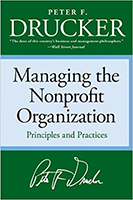 Managing the Nonprofit Organization
Managing the Nonprofit OrganizationBy Peter F. Drucker
New York: HarperCollins, 1990, 224 pp.
Reviewed by Steve Dunham
Hospitals, churches, Boy Scouts, and Girl Scouts “have something in
The book has five parts:
“The ultimate test” of the mission, wrote Drucker, “is right
“The first step toward effectiveness is to decide what are the right things to do. Efficiency, which is doing things right, is irrelevant until you work on the right things”
“The three ‘musts’ of a successful mission”: “Look at strength and performance. Do better what you already do well—if it’s the right thing to
“Organize yourself to see the opportunity,” wrote Drucker.
“The organization that starts out from the inside and then tries to find places to put its resources is going to fritter itself away. Above all, it’s going to focus on yesterday.”
“One always has to ask: Is this action step leading us toward our basic long-range goal, or is it going to sidetrack us, going to divert us, going to make us lose sight of what we are here to do?
“… also, we need to be result-driven. We need to ask, Do we get adequate results for our efforts? Is this their best allocation?”
“Performance means concentrating available resources where the results are. It does not mean making promises you can’t live up to.
“Equally dangerous is the opposite—to go for the easy results rather than for results that further the mission”
Having identified their mission, nonprofits must work for results
The goals, however, are not necessarily permanent. Managers of nonprofits “have to build in review, revision, and organized abandonment” of goals (goals have to be abandoned once they have been met)
One key to managing a nonprofit is its leadership, to which Drucker devoted a substantial part of the book.
He listed basic leadership competencies
“The least effective decision makers are the ones who constantly make decisions. The effective ones make very few. They concentrate on the important decisions. And even people who work hard in making decisions often misapply their time. They slight the important decisions and spend executive time making easy—or irrelevant—decisions”
“Leadership is accountable for results. And leadership always asks, Are we really faithful stewards
In some nonprofits, “everybody is a leader, everybody is responsible, everybody acts”
Volunteers are a major part of many nonprofits. With volunteers, said Drucker in an interview with Frances Hesselbein,1 “You determine their job, you set the standard, you provide the training, and you basically set their sights high”
“You forgot one point—the recognition, replied Hesselbein.” It is important that someone says: ‘Thank you very much, you’ve made a major contribution’”
With Max de Pree,2 Drucker discussed developing people
Peter Drucker: You develop people, notjobs … Max de Pree: We’re talking about building on what people are—not about changing them. To understand their gifts, to understand what their potential is.
“We all tend to take temperament and personality for granted. But it’s very important to take them seriously and to understand them clearly because they’re not too subject to change by training”
Many nonprofits confuse marketing with sales and advertising
Philip Kotler: [Marketing involves] studying the market, segmenting it, targeting the groups you want to service, positioning yourself in the market, and creating a service that meets needs outthere.… Many organizations are very clear about the needs they would like to serve, but they often don’t understand these needs from the perspective of the customers. They make assumptions based on their own interpretation of the needs out there.
… first, do some customer research to understand the market you want to serve and its needs. Second, develop segmentation and be aware of different groups that you’re going to be interacting with. Third, develop policies, practices, and programs that are targeted to satisfy those
groups.… Toomany … non-profit organizations go right into advertising before they’ve gone into the other three steps, and that’s really doing things backwards.
“You don’t start out with your product but with the end, which is a satisfied customer.
“The most important person to research is the individual who should be the
A nonprofit’s money “is held in trust for the donors. And the board is the guardian to make sure the money is used for the results for which it has been given”
“A non-profit needs a strong board”—it “helps think through the institution’s mission, it is the guardian of that mission, and makes sure the organization lives up to its basic commitment. The board has the job of making sure the non-profit has competent management—and the right management”
“Boards have to be given their work plan”
From an interview with Rev. David Allan Hubbard:4
David Hubbard: A board needs to know that it owns theorganization.… Board members don’t own it as though they were stockholders voting blocks of stock; they own it because theycare.… They actually own it in partnership because, in a sense, the organization belongs just as much toothers.… [A board member is] governor, sponsor, ambassador, and consultant.
On building the donor constituency, from an interview with Dudley Hafner
Dudley Hafner: [In approaching a donor] we present a case for support which spells out the magnitude of the challenge, what we propose to do about it, how realistic it is to achieve that challenge, and how your gift can make adifference.… we might ask you to get involved in some of ouractivities.… Technology has given us the means to go out and probably do a pretty good job of raising money through the computer, through mail drops or telemarketing that leave out the volunteer. But that would be a tragic mistake because in the process you’ve also lost the constituency, you’ve lost the volunteer base, you’ve lost the course of strength and growth in the organization. I see technology as a way of helping the volunteers do a more effective job; I do not see it as a replacement for a
volunteer.… the decision that it’s easier to raise money without involving the volunteers [is] a fatal mistake.
Nonprofit institutions “have a greater propensity for conflict than businesses precisely because everybody is committed to a good
“… an American political scientist, Mary Parker Follett, said that when you have dissent in an organization, you should never ask who is right. You should not even ask what is right. You must assume that each faction gives the right answer, but to a different question”
Common mistakes (pp. 69 71) Drucker cited:
“It is a mistake to focus only on change and forget what you already do well”
Although the book was published in 1990, I found it relevant today and worthwhile reading as the chairman of a nonprofit board (of the Virginia Association of Railway Patrons).
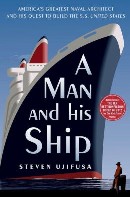 A Man and His Ship: America’s Greatest Architect and His Quest to Build the
A Man and His Ship: America’s Greatest Architect and His Quest to Build the By Steven Ujifusa
New York: Simon & Schuster, 2012
370 pp.
Reviewed by Steve Dunham
William Francis Gibbs was enchanted by ships ever since, as a child, he watched the launching of the
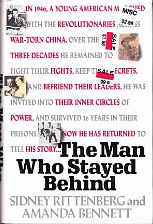 The Man Who Stayed Behind
The Man Who Stayed BehindBy Sidney Rittenberg and Amanda Bennett
New York: Simon & Schuster, 1993
Reviewed by Steve Dunham
ANSER Transmissions, March 2001, copyright 2001 Analytic Services. Used by permission.
Sidney Rittenberg, a U.S. Army translator stationed in China at the end of World
Rittenberg, outraged by this injustice, was at the same time growing to love China, and was appalled by the corruption he saw all around him. Engaged in delivering relief supplies, he found that the cargoes of rice were often stolen by the Nationalists and sold for profit—sometimes to the very relief agencies that had donated them. On one relief mission, he had a splendid dinner in a monastery, while people in the town nearby were starving. He resolved to help build a better China.
So that he could stay in China after his Army discharge, he secured a job with the United Nations. He found, during a trip delivering relief supplies to Communist-held territory, that the food was being equitably distributed there, and he saw little of the misery and squalor that had been common in other parts of China: beggars, prostitutes, and people shot by the authorities for no reason.
In America before the war, Rittenberg had been a card-carrying Communist; he had renounced his membership, but not his beliefs, in order to join the Army.
Now he joined the Communist rebels and accompanied them on their marches. He married a Chinese woman. He served as a translator at meetings involving the Communists, Nationalists, Americans, and UN. Although he seemed to find acceptance in a country he had come to love, he was imprisoned as a spy within one year.
Six horrific years passed before he was released: he was tortured, drugged, and, by the time he was released, virtually insane. By then the revolution was over and his wife had divorced him. Still, he considered himself a loyal Communist. He worked in the foreign broadcast ministry and considered himself a friend of Premier Zhou Enlai. He married again, this time to a woman who said she would never divorce her husband just because he was imprisoned. She was true to her word. During the Cultural Revolution of the mid-1960s, Rittenberg eagerly joined in the calls for freedom of speech and denounced corrupt leaders. The Cultural Revolution was merely another tactic of Communist Party Chairman Mao Zedong to expose and eliminate enemies, however, and Rittenberg committed political errors and found himself once more imprisoned—this time for
This fear, he said, was realized. Offered another well-paid prominent position in the Chinese government, he turned it down and, with his wife, went to the United States. One by one, their four children, by now grown, followed. Although acknowledging the material progress China has made since the end of World
This book was hard to stop reading. The culture is alien, as at times is the author himself. Although for most of his life, his politics and ideology were widely divergent from those of most Americans, his experiences are those of a human being in a Communist nation, providing a fascinating view of
The enigma that is China remains partly hidden from Western eyes, but Rittenberg’s book offers a valuable view of the nation as seen by a resident foreigner with inside connections and, even more important, as seen by its Communist party.
 Nixon’s Vietnam War
Nixon’s Vietnam WarBy Jeffrey Kimball
Lawrence, KS: Univ. of Kansas Press, 1998
371 pp.
Reviewed by Steve Dunham
ANSER Transmissions, November-December 1999, copyright 1999 Analytic Services. Used by permission.
The Vietnam War continues to attract study from those desiring to learn from the lessons of history. Americans continue asking—and answering—the question “What went wrong?” Jeffrey Kimball, a professor of history at the University of Kansas, looks in particular at the conflict as conducted by the Nixon administration, which inherited the undeclared war from the Johnson administration.
Kimball is unsympathetic to Nixon; though this colors Kimball’s conclusions, the history offered here, however interpreted, sheds much light on Nixon’s decisions and actions.
Kimball describes how Nixon, beginning when he was Vice President under Eisenhower, favored military victory in Vietnam, considering even the use of nuclear weapons, and wishing the other side to fear a nuclear attack even after he had stopped considering it. This intentional aura of unpredictability and its expected effect of keeping the enemy off balance was called, within the White House, the madman theory. Kimball describes other aspects of the Nixon-Kissinger management of the war and the associated diplomacy: negotiations with the USSR linked to Vietnam and détente, and triangular diplomacy, a partially successful effort to get China and the USSR to pressure North Vietnam to come to terms.
Although Nixon claimed to pursue victory, like Johnson before him he failed to prosecute the war in a coordinated effective way or to let the military do so, instead swinging between aggressive action and attempts at a negotiated settlement, with the effect of achieving neither victory nor peace until the 1973 cease-fire, which satisfied no one except the North Vietnamese.
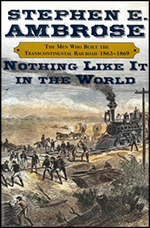 Nothing Like It in the World: The Men Who Built the Transcontinental Railroad
Nothing Like It in the World: The Men Who Built the Transcontinental RailroadBy Stephen Ambrose
New York: Simon & Schuster, 2000
Hardcover, 366 pp.
Reviewed by Steve Dunham
This book is about the construction of the railroad and especially the men behind it: Theodore Judah, who explored the route and promoted the railroad’s construction but didn’t live to see it completed; the Big Four—Leland Stanford, Collis Huntington, Charles Crocker, and Mark Hopkins—who financed and oversaw construction of the Central Pacific eastward from Sacramento; Grenville Dodge, chief engineer of the Union Pacific, building westward from Omaha; Samuel Reed, chief of construction for the Union Pacific; Union Pacific vice president Doc Durant; and many more. They weren’t confident that the railroad woud be profitable to operate, so they arranged matters to get their profits from its construction, particularly via the infamous Crédit Mobilier, through which the Union Pacific financiers grabbed immense profits while the actual construction workers went unpaid. The federal government helped finance the line with land grants and bonds.
The government bonds were granted upon completion of segments of the railroad, so the railroads raced to complete miles of line in order to obtain bonds to sell and finance further construction. The Central Pacific’s Charles Crocker said that the government inspectors would accept the poorest railroad he could build, but the Central Pacific was built well in the mountains. Because Congress did not designate a meeting place, the Union Pacific and Central Pacific built past each other in Utah, with the Central Pacific setting a record of ten miles of track laid in one day. The Union Pacific, in particular was built cheaply, using cottonwood ties in place of better timber because everything had to be shipped in from the East. Once the line was in place, it was easier to bring in supplies to improve the railroad.
The Central Pacific had an immense, years-long struggle to build across the Sierra Nevada. Tunnels had to be blasted through granite, and
The Union Pacific’s construction site was followed by an assemblage of gamblers, prostitutes, and criminals known as Hell on Wheels who exploited the laborers.
In 1869, the railroads finally joined and united East and West. Americans were delighted, and a transcontinental journey that had required months now took a few days.
The book is interesting but has a lot of errors: in a few places
The book is sprinkled with bizarre statements too: Ambrose repeatedly refers to westward migrants as “argonauts”; he says
This book is fairly easy to read but not entirely reliable.
After reviewing this book, I learned of a web page devoted to the errors in it: “The Sins of
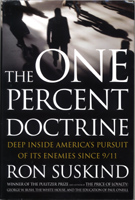 The One Percent Doctrine: Deep Inside America’s Pursuit of Its Enemies Since 9/11
The One Percent Doctrine: Deep Inside America’s Pursuit of Its Enemies Since 9/11By Ron Suskind
New York: Simon & Schuster, 2006
351 pp., $27 hardcover
Reviewed by Steve Dunham
Journal of Homeland Security, 2006. Copyright 2006 Analytic Services. Reproduced by permission.
Suskind, drawing on nearly one hundred sources, details the
Yet some things were certain:
Even without reports of
Such serious subject matter deserves careful writing, but unfortunately the book frequently falls short. Take the central concept of the book: what is “a one percent chance of the unimaginable coming due”? Did Suskind mean coming true? Or that the United States would be getting its due (like a bill coming due)? The heart of the book is no place for cryptic statements.
There are other puzzles in his wording. What is “the warm commuter buzz,” and what does “That month, 119 the Israel” mean?
Other assertions cry out for explanation—for example, that the Cheney–Rumsfeld–
Repeatedly, Suskind writes as though what he has to say is self-evident, prefacing statements with “of course.”
He repeatedly alludes to but does not cite Cheney’s
In other places, the word choice is poor, ambiguous, or wrong: verbal in place of oral; gasoline on a fire as “a catalytic relationship”; Oliver Wendell Holmes’s phrase “all deliberate speed” (signifying steady, deliberate progress) apparently used by Suskind to mean something else; actionable used in its vogue meaning of “giving grounds for action,” producing perhaps unintentional irony because of its primary meaning, “giving grounds for a lawsuit.”
Some of the persons in the drama are described with formality: Bush, Cheney, and Rumsfeld are denoted by surname, full name, or title. Toward others, does Suskind feel chummy? Secretaries of State Powell and Rice he sometimes calls Colin and Condi.
Suskind has produced a coherent inside narrative of the “War on Terror,” and he relies mainly on anonymous sources; more care in his writing would have inspired greater confidence that he had communicated every quote and fact accurately, especially since he describes a government on the edge of panic.
His book is worth reading just the same, and perhaps future writers will corroborate his revelations and a future edition of this book will correct its shortcomings, for as a work of journalism, it is, after all, merely a first draft of history.
 Peace in the Storm: Meditations on Chronic Pain and Illness
Peace in the Storm: Meditations on Chronic Pain and IllnessBy Maureen Pratt
New York: Gallilee, 2005
329 pp.
Reviewed by Steve Dunham
More than one hundred meditations on topics from “Why Me?” to “Becoming Addicted to Prescription Medication” plus messages of hope such as “Living the Divine Life” and “The Joy in Nature.” The author’s faith shines through on every page. Sometimes I wondered whether she was for real. My conclusion: yes. In the introduction and in some of the medidtations, she describes her own struggle with lupus and the pain, fatigue, and endless medical difficulties associated with it. Those experiencing chronic pain or illness themselves or assisting a family member or friend through such challenges and who are open to looking at it with faith will find this a helpful book.
 Pilgrimage and Exile: Mother Marianne of Moloka‘i
Pilgrimage and Exile: Mother Marianne of Moloka‘iBy Sister Mary Laurence Hanley, OSF, and O. A. Bushnell
Honolulu: Mutual Publishing, 2009 (revised edition of
Reviewed by Steve Dunham, copyright 2023
It’s a vivid, poignant, inspiring book. Marianne Cope (nee Barbara Koob) was a Franciscan sister in upstate New York, at various times serving as Mother Superior and head of her Franciscan province and managing
In Hawaii, starting in 1883, the sisters worked at Kakaako, the receiving station for leprosy patients, and transformed it into a somewhat tolerable place, though two years later it was still a “foul prison,” in the authors’ words. The sisters also staffed a hospital and school on Maui. With help from the king and queen, they got formally established. Although the sisters thought they might eventually return to New York state, after a while Marianne Cope realized that she would need to stay in Hawaii for life, and nearly all of the sisters who joined her initially and over the years spent the rest of their lives there too.
When Father Damien de Veuster on Molokai, to which people with confirmed cases of leprosy were banished, could see that he would not live a lot longer, he told Marianne Cope that the Franciscan sisters would have to carry on the work there. In fact, Brother Dutton and other religious brothers continued to serve the boys and men, but a new home for women and girls (the Bishop Home, named for a benefactor), was built; it was then staffed by the sisters.
With firmness and gentleness, Marianne Cope governed her community, worked with (and sometimes disputed with) the local government, and received the affection of almost all who knew her. She died on Molokai in 1918 at age 80.
Much of the story is told in the words of Sister Leopoldina, who at Marianne Cope’s request kept a journal of events. Other sources provide much of the history; Marianne Cope herself wrote little.
The book has some flaws. Some parts from A Song of Pilgrimage and Exile (1980) refer to 1980 as the present.
Hawaiian belief, such as “mana, the spirit-power granted by the gods,” is stated as fact.
Besides the history, the book contains a lot of supposition and speculation: things that probably happened, must have happened, no doubt happened, and things that people probably thought or never thought. “The years she [Marianne Cope] spent as a factory worker must have
Some people, especially men, get harsh words without much substantiation: Bishop Koeckemann, Gibson, and
There are numbered chapter notes, but there are no corresponding numbers in the text. For example, some of Gibson’s thoughts are in
Although the book could have been better, it’s a comprehensive story of Saint Marianne Cope.
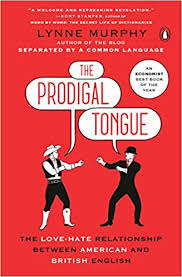 The Prodigal Tongue
The Prodigal TongueBy Lynne Murphy
New York: Penguin, 2018, 298 pp.
Reviewed by Steve Dunham
Although the American and British versions of English are so similar that we can communicate easily (for the most part), the differences can be irksome (mostly to some British) or enviable (mostly to some Americans).
In the first chapter, “The Queen’s English, Corrupted,” Murphy takes on the British complaint that “Americans are ruining the English language,” along with the attitude that she calls “amerilexicophobia.” She puts up a strong defense of American English—a little too strong, I think; she comes across as somewhat combative, pointing out, for example, that a lot of the supposed Americanisms are actually words or expressions that originated in Britain but withered on that side of the Atlantic.
The rest of the book is more relaxed and entertaining. Murphy addresses stereotypes, differences in vocabulary and phrasing, logical and illogical arguments about the differences, English in other countries, and whether the United States and Britain are indeed “Separated by a Common Language,” which is the name of her blog.
The one improvement I would suggest for her next book is to include more comments from readers of her blog, from which I learned a lot not just about differences between British and American English but about regional differences in American English as readers from different parts of the United States described their English usage.
That quibble aside, I recommend this book; it is enjoyable and worth reading.
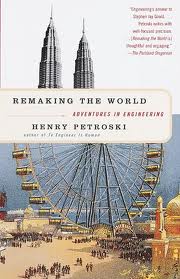 Remaking the World: Adventures in Engineering
Remaking the World: Adventures in EngineeringBy Henry Petroski
New York: Alfred A. Knopf, 1997
212 pp.
Reviewed by Steve Dunham
ANSER Transmissions, January-February 2000, copyright 2000 Analytic Services. Used by permission.
These readable essays describe engineering in its social context: how, why, and when things are designed to answer the needs of society—what Henry Petroski, a professor of civil engineering and of history at Duke University, calls “engineering in context.”
He quotes ANSER board member George Bugliarello as saying (at a 1990 symposium on “Engineering as a Social Enterprise” sponsored by the National Academy of Engineering) that engineers have been relegated to a “mainly technical role in the engine compartments
His book contributes to that goal by describing engineers and engineering projects in their social context, revealing the forces that led to (or stalled) inventions and why things like the English Channel tunnel and the Petronas Towers were built when and where they were.
Petroski profiles engineers such as Henry Martyn Robert, designer of the Galveston seawall and creator of Robert’s Rules of Order; James Nasmyth, artist and inventor of the steam hammer; and Isambard Kingdom Brunel, designer of the mammoth (by 1858 standards) steamship Great Eastern. Engineering projects described briefly include the Panama Canal, the Ferris wheel, the English Channel tunnel, and the Petronas Towers in Kuala Lumpur, Malaysia.
Each of these people and projects both shaped and was shaped by society. Robert designed the Galveston seawall after the devastating hurricane of 1900 drowned
Nasmyth invented the steam hammer because no machine existed to create a large iron shaft for the paddle wheels of the steamship Great Britain; when the ship was redesigned to use propellers instead, the steam hammer remained unbuilt until railroad expansion in Britain made it economical.
Brunel designed his first steamship, the Great Western, to carry passengers across the Atlantic from the terminus of the Great Western Railway at Bristol. It was the first steamer large enough to carry enough fuel to cross the ocean. His Great Eastern,
The Panama Canal was at first a massive failure because the French engineer Ferdinand de Lesseps, mastermind of the Suez Canal, was unprepared for the soil, topography, and diseases of Central America.
The Ferris wheel was created by George Ferris for the 1893 Columbian Exposition in Chicago, which wanted a monumental centerpiece to rival the
The Petronas Towers at 1,482 feet tall
In producing these interesting vignettes, Petroski reminds those of us who work with technology that science and engineering are neither purely masters nor purely servants of society, but forces that both mold society and respond to it.
* The United States had offered Colombia
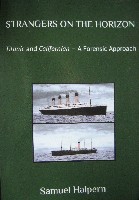 |
Reviewed by Steve Dunham
Posted June 29, 2023
Concerning the Titanic disaster, “The evidence that is available to us is a mass of contradictions, inconsistencies, and improbabilities,” the author notes. The sworn testimony at hearings on the Titanic disaster, as well as memoirs by the participants, rely partly on things witnessed in the dark of night, recalled (in the case of memoirs) sometimes years afterward, and sometimes presented as self-justification. This detailed book uses navigational information, reported bearings, charts of how far apart things can be seen at sea, ships’ logs, radio transmissions, and much more to analyze the reported positions and movements of the Titanic, Californian, and other ships on the night of
This book presents a convincing case that the Californian was not
Halpern says that both the Californian and the Titanic were carried southward by the Labrador current (the Titanic’s drift is indicated by the distance between the point of rescue and the location of the shipwreck on the ocean floor), with the Californian’s drift accounting for its reckoned stopped position for the night and its position in the morning.
Halpern posits that the errors in the distress position radioed by the Titanic may have been caused by an hour too much of travel in Captain Edward Smith’s calculations (he placed the ship about
Californian’s “logbook had a stopped position that was used to claim that Californian was about 19½ to
When a brightly lit passenger ship came in sight, Captain Stanley Lord of the Californian insisted (he claimed later) that it was not the Titanic, and he ever afterward maintained that the Titanic was never visible from the Californian that night. He at first insisted to the press that no rockets were seen from the Californian that night.
Lord said he was told of only one rocket spotted and did not recall asking whether all the rockets seen by his officers were white (he testified that he had been asleep when the apprentice officer, James Gibson, came to the chartroom where Lord was sleeping and reported that eight rockets had been seen). A mix of colors in the rockets might have indicated company signals. All white rockets meant a distress signal.
The ship seen from the Titanic before the Titanic sank seemed to sail away. Halpern indicates that the motion of the Titanic and the Californian (both were swinging) may have accounted for the impression that the Californian was getting farther away and that the ship seen from the Californian was steaming away; as the ships swung, some of their lights would have become invisible to the other ship.
The distress rockets seen from the Californian were off that ship’s starboard beam, placing the Titanic to the southeast. The Californian’s second officer, Herbert Stone, however, reported that the ship he had in view sailed off to the southwest. Halpern proposes that the Californian may have started swinging in the other direction without Stone’s noticing, changing the relative bearing to the Titanic (Stone also said that the rockets moved to the southwest too). Was there a ship between Californian and Titanic? Stone said that the rockets appeared very low in the sky, not reaching as high as the masthead light of the ship he was watching. He suggested that the rockets might have come from another ship beyond the one he could see, although he told the British Inquiry he was sure that one of the rockets, which appeared brighter than the others, came from the ship he was watching. At the British inquiry, Lord and Chief Officer Frederick Stewart said they saw a ship with four masts and a yellow funnel to the south between the Californian and where the floating wreckage from the Titanic was found. The description matches the Mount Temple, but that ship was on the other side of the ice field. From the charts in this book, it appears that the Mount Temple could have been due south of the Californian at daybreak, but not between the Californian and the floating wreckage of the Titanic; however, Lord stated that the ship with four masts and a yellow funnel was on the east side of the ice field and that Stewart supposed it was the ship that had been firing rockets. “Albert Foweraker, a supporter of Captain Lord,” said there were seven mystery ships in the area on the night of the disaster.
Leyland Line lawyer Robertson Dunlop claimed that three or four other steamers had been nearby on the night of the disaster (possibly true: the Mount Temple, Almerian, and Birma were in the area but separated from the Titanic by the ice).
The Marine Accident Investigation Branch of Britain’s Department of Transport 1992 investigation, based on the new knowledge of the Titanic’s actual wreck location, concluded that the Titanic and the Californian were in sight of each other while the Titanic was sinking but, in the final report, concluded that maybe they were not. Halpern, based on what could be seen from the Californian (such as the Titanic’s and Carpathia’s rockets), rebuts the final report’s finding.
Some relatively minor faults in Strangers on the Horizon: The author places too much emphasis on lookout Fleet’s words “Are you there?” which did not imply that he heard no response when he called the bridge; “Are you there?” was an early telephone greeting later superseded by “Hello.” Also, Halpern doesn’t address the possibility that the Almerian’s report in Stanley Lord’s handwriting was a copy that Lord made by hand but did not author.
Chapter XVI relies perhaps a little too heavily on newspaper reports. In some cases, various news stories reported essentially the same things, especially Lord’s statement that the Californian’s latitude and longitude when receiving the Virginian’s message that the Titanic had sunk was a “state secret,” suggesting credible reporting, but solitary reports, such as that Captain Lord of the Californian stated that the radio did not work when the engines were shut down, may reflect a reporter’s misunderstanding rather than a threadbare lie by Lord.
There are also many statements about what people were thinking: “Of course, nobody gave any consideration,” “no real thought was ever given,” and many references to what mystery ship advocates think—more quotes from them would have been better than saying what they think.
Quotes from the “Lordites” (advocates of the Californian’s Captain Lord) would have been better than statements of their positions, and the rebuttal section would have been better if Halpern had replied using the forensic approach stated in the book’s title.
I also wish that the author had presented a chart showing where he thinks all the nearby ships were at one time (such as when the Titanic’s first call for help went out); the Titanic’s location is known from the wreckage, but the positions of some other ships are still the subject of controversy; Halpern presents Captain John Knapp’s charts and explains the errors in them but does not present a comprehensive chart reflecting his own conclusions and estimates. I would like to know too his assessment of the unknown ships seen around
I also wish that the index were a little more detailed. There are only seven entries for Californian, for example, but at least they specify the topics covered at different places; there are about
The book has some significant flaws, mostly in presentation: many of the graphics, particularly the charts, are not sharply printed, and there are a lot of misspellings, grammatical faults, and what look like errors in transcription of quotes. One photo appears twice
The Titanic’s crash into the iceberg is sometimes called a collision, sometimes an allision.
Some other errors involve time: in at least three places, a.m. should be p.m. or vice versa.
Some of the misspellings: statue mile instead of statute mile, access instead of assess, such a instead of such as, Justice of the Piece instead of Justice of the Peace, know location instead of known location, Evens instead of Evans, lue instead of lieu, ascertion, connon, vehiment, infinitly, Faweraker instead of Foweraker, and Cottom instead of Cottam.
Some of the grammatical faults: each of who, is also be used, 8 to
Apparently transcription errors: Quartermaster Walter Perkis quoted as saying though instead of thought, cart appearing in one quote, chart in another on the same page, Knapp quoted as writing, “according shape” and “act an a,” Lord Mersey quoted as writing were instead of where, “the evidence
Strangers on the Horizon has room for improvement, but it is a welcome book, probably unique in its approach.
 A Tainted Dawn
A Tainted DawnBy B. N. Peacock
Tucson, AZ: Fireship Press, 2012, 239 pp.
Reviewed by Steve Dunham
Three young men—two English, one French—cross paths again and again in the late 1700s. The lad who gets the most attention is a sea captain’s son who inherits his father’s estate but struggles to keep it against the plotting of other relatives. Only a teenager, he is appointed a midshipman in the navy, and he faces severe disadvantages as he tries to prove himself. The other English boy is a fiddler and sometime carpenter who, mainly to escape troubles at home, runs away to sea and joins the same ship as the other boy. The young Frenchman is a revolutionary who is keeping his rebellion secret from his family; at one point he flees to the Caribbean, where the troubles in France are distant and revolution has not yet taken hold. Unknown to one another, they all cross paths in chapter one, and their fates are intertwined.
Their personal conflicts take place against the background of the French Revolution and a threat of war possibly involving England, France, and Spain. Much of the action takes place on board Royal Navy ships; other scenes include Paris, London, and the Caribbean. Peacock seems to have done her homework, with convincing details and dialogue. This is a well-crafted novel with well-drawn characters. It is intended as the first book of a trilogy, and the novel ends with the immediate tensions resolved but the characters’ future uncertain. My only complaints were that the first chapter introduced so many characters that I had trouble remembering who they all were, and that the book contained quite a few typos. Once immersed in the story, however, I found it hard to stop reading. I look forward to reading the next two books in the saga.
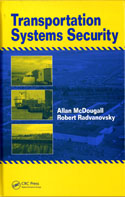 Transportation Systems Security
Transportation Systems SecurityBy Allan McDougall and Robert Radvanovsky
Boca Raton, FL: CRC Press, 2008
222 pp., $69.95 hardcover
Reviewed by Steve Dunham
Journal of Homeland Security, August 2010. Copyright 2010 Analytic Services. Reproduced by permission.
In Transportation Systems Security, the authors attempt to present the “strategic, operational, and practical considerations involved in the implementation of physical, procedural, and managerial safeguards required to keep all modes of transportation up and running during an actual or potential disaster.” Noting that “to deter or prevent something from
The book offers some insight into the risks and vulnerabilities of transportation systems—especially how risk varies throughout the movement of cargo and people and how this changing risk must be addressed in planning and managing security. The authors point out that critical infrastructure protection “does not lie primarily with the protection of a given infrastructure but with the maintenance and protection of capacity across the transportation system.” The book even proposes a few innovative concepts, such as establishing an information sharing and assessment center “as a for-profit business.” It discusses topics such as system topography, mission analysis, risk mitigation, continuity of operations, trusted networks, learning systems, and fragility analysis. Everything is discussed in terms of strategic, operational, and tactical levels. Some of the chapters have good questions at the end.
But the writing is poor, marred by typos and frequent faults in English. Often it is tediously abstract or obtuse (for example, “Looking at efficiency and time, the perception begins to look at aspects of space”; also, the strategic level must “requite baseline levels” with requirements). The fictional
In many places, words seem to be missing, and it’s often hard to tell what meaning was intended (for example, “Although both these sides have some merit, some might reasonably argue that what needs for a balance between the two systems”). Elsewhere, possibly omitted words may reverse the likely meaning (for example, “Ignoring risk means that management remains accountable and responsible not for any losses associated with the
Some content seems unfinished, with the details never filled in, as in
The “Manager’s Working Tool” in Appendix B “is intended to assist managers in looking at their organizations in terms of infrastructure assurance and capacity management.” These
On the whole, the book has some useful material, but it is probably not lucid enough for students of the subject or for managers to use on their own in creating a transportation systems security plan.
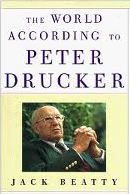 The World According to Peter Drucker
The World According to Peter DruckerBy Jack Beatty
New York: The Free Press, 1998
188 pp.
Reviewed by Steve Dunham
ANSER Transmissions, March-April 2000, copyright 2000 Analytic Services. Used by permission.
“Drucker,” writes Jack Beatty, “has been called every thing from ‘the father of management’ to ‘the man who changed the face of industrial America’ to ‘the one great thinker management theory has produced.’ On inspection these and other encomia about him turn out to be within caviling distance of being true.”
Beatty, senior editor of Atlantic Monthly, had edited several of Drucker’s articles but still considered himself a “rookie” at management theory. In this book Beatty has provided a critical portrait of Drucker’s work, summarizing the development of Drucker’s thought on management as expressed in more than two dozen books and revealed in personal interviews.
Drucker is a native of Austria, and his first published writings were anti-Fascist polemics. His career in management theory began with the 1939 publication of
In studying big corporations, Drucker discovered early on that managers had become accountable to no one but themselves. Unlike small companies in which the owners are also the managers, big corporations tended to be owned by stockholders and governed by boards who did not directly interfere with management (although stockholder and board involvement has increased in recent decades). This had profound social impact.
In The End of Economic Man, Drucker indicated the failure of capitalism to produce a just society. Much of his subsequent work has dealt with remaking society by changing the way corporations are managed. Responding to the dearth of accountability in corporate management, Drucker has, surprisingly for a management aficionado, been pro-union, writing that unionism “is a brace needed by a social body suffering from curvature of the spine,” and, “Modern society, a society of organizations each requiring strong management, needs an organ such as the labor union.” The need to control and direct corporations is a major theme of Drucker’s work. The reason is the corporation’s impact on people.
Although Drucker’s object of study is the corporation, his focus is on people. He is a philanthropist who devotes half his consulting effort to pro bono work and uses the Drucker Foundation to improve the management of nonprofits. “Those of us who have been spared the horrors in which our age specializes, who have never suffered total war, slave-labor camp or police terror, not only owe thanks, we owe charity and compassion,” he wrote in 1959.
This focus on people led to revolutionary conclusions: that employees are a resource, not a cost, and that managers should measure performance, not personality. “An employer has no business with a man’s personality,” Drucker wrote in 1974. “Employment is a specific contract calling for specific performance … An employee owes no ‘loyalty,’ he owes no ‘love’ and no ‘attitudes’—he owes performance and nothing else.” Yet one of Drucker’s fundamental goals has been to instill the “managerial attitude” in employees: to make them work as if they owned the company. Beatty notes that under this arrangement, “the
But Drucker also proposed lifetime employment—a concept adopted by many companies in Japan, where Drucker’s concepts were first carried out in full measure. Conversely, Drucker has maintained that management concepts are good for about
Flexibility is key to the Drucker concept of management. “It is certain that the unexpected will happen; but it is impossible to predict where, when, or how,” he wrote in Managing for the Future.
The risky business of innovation is an essential ingredient in Drucker’s concept of management, as is the latitude to take risks. “The better a man is,” according to Drucker, “the more mistakes he will make—for the more new things he will try. I would never promote a man into a top-level job who had not made mistakes, and big ones at that.”
He considers integrity to be another essential managerial quality. “Drucker,” writes Beatty, “sees integrity as a kind of social faith—residing in a generous attitude toward other people’s possibilities and a leniency toward their limitations.” He believes in giving people chances to succeed. He disagrees with most corporations’ emphasis on academic credentials in hiring and opposes “limiting access to opportunity to those with a diploma.”
“Drucker looks forward to the day when state legislatures will sponsor referenda to ban questions in employment applications about ‘educational status,’” writes Beatty, noting Drucker’s comment that academic ability is “an accident of birth, and not a very meaningful one at that.”
The man who coined the term “knowledge worker” does not equate knowledge with education. “Knowledge has become ‘the’ resource, rather than ‘a’ resource,” he says, but believes that the knowledge that is valuable to a corporation comes from experience and continued training, not just academia.
His emphasis is on performance, results, and entrepreneurship. The “Drucker dictum best known around the world,” writes Beatty, is “There is only one valid definition of business purpose: ‘to create a customer.’” The corporation must identify itself with meeting the needs of not only current customers, but those who should be customers in the future.
Drucker pans anything that detracts from this focus, including many business buzz words:
Although the Drucker philosophy has shaped corporate management for more than
But management, says Drucker, has come a long way. “The most important reason for focusing on business management is that it is the success story of the century.” Yet he realizes how far corporate America is from utopia when he says, “I couldn’t work in a large organization. They bore me to tears.”
Any review without somebody else’s copyright may be reproduced as long as you give credit.